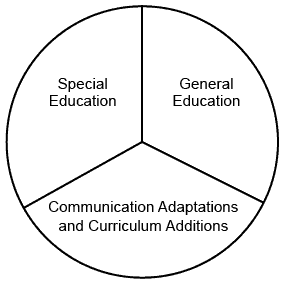Communication Considerations A-Z™:
Deaf Education
[ Download printable pdf of this document ]
[ Back to Table of Contents ]
1) What is Deaf Education?
A composite of:
General Education – Education for all students focusing on: (1) educational standards, content and processes taught, (2) how it is taught, and (3) assessment of learning.
Special Education – Accommodations and modifications to the general education program so students have access to academic and social learning experiences.
Communication Adaptations and Curriculum Additions – Hearing loss related communication alterations (e.g., FM System, American Sign Language) so students have access to the learning and social environment. Curriculum additions will likely vary depending on the student’s preferred method of communication (e.g., speech, auditory training, Deaf studies).

Each individual student who is deaf or hard of hearing has unique needs that should be considered relative to any or all three categories. Communication Adaptations and Curriculum Additions could be addressed in both general and special education programs.
2) What are the Issues at the Forefront of Deaf Education?
Each issue listed below exists for several overlapping reasons:
- Hearing loss is a low-incidence disability - 0.11% of the estimated school-age population and 1.2% of all students with disabilities.
- Heterogeneity of the population – Examples include: degree and type of hearing loss, age of identification, preferred mode of communication, and educational setting.
- The field has been fueled by strong emotion, rather than demonstrated efficacy.
Issues
- Improving educational outcomes, including literacy, numeracy, and employability.
- Increasing research to establish effective educational practices.
- Providing appropriate educational services for students with additional disabilities and for those who are culturally and/or linguistically diverse.
3) What Should Every Parent and Professional Know About Deaf Education?
These are exciting times because of:
- Growing awareness that families play the central role in the development of healthy, knowledgeable, and compassionate children.
- Positive outcomes occurring from newborn hearing screening and early intervention.
- Higher expectations for students who are deaf or hard of hearing.
- Increased access to educational and community activities for individuals who are deaf or hard of hearing.
- Improved technology – better-quality hearing aids, cochlear implants, videophones, and the Internet.
- Successful deaf adults – some sign, some speak, and some sign and speak.
- Desire to conduct more and better research on educational practices.
4) Deaf Education Resources
Moores, D.F., & Martin, D.S. (Eds.). (2006). Deaf learners: Developments in curriculum and instruction. Washington, DC: Gallaudet University Press.
National Association of State Directors of Special Education, Inc. (2006). Meeting the needs of students who are deaf or hard of hearing: Educational service guidelines. Alexandria, VA: Author.
Rittenhouse, R.K. (Ed.). (2004). Deaf education at the dawn of the 21st century: Old challenges, new directions. Hillsboro, OR: Butte Publications, Inc.
Stewart, D.A., & Kluwin, T.N. (2001). Teaching deaf and hard of hearing students: Content, strategies and curriculum. Boston: Allyn and Bacon.
The National Agenda: Moving forward on achieving educational equality for deaf and hard of hearing students (April, 2005).
Author:
John L. Luckner, Ed.D. is a professor in the School of Special Education at the University of Northern Colorado. His current research interests include literacy, assessment, and the provision of appropriate services for students who are deaf or hard of hearing. Address: John Luckner, University of Northern Colorado, Campus Box 141, Greeley, CO 80639-0248; email: john.luckner@unco.edu
-----------------
* Communication Considerations A to Z™ is a series from Hands & Voices that's designed to help families and the professionals working with them access information and further resources to assist them in raising and educating children who are deaf or hard of hearing. We've recruited some of the best in the business to share their insights on the many diverse considerations that play into communication modes & methods, and so many other variables that are part of informed decision making. We hope you find the time to read them all!
 Home
Home